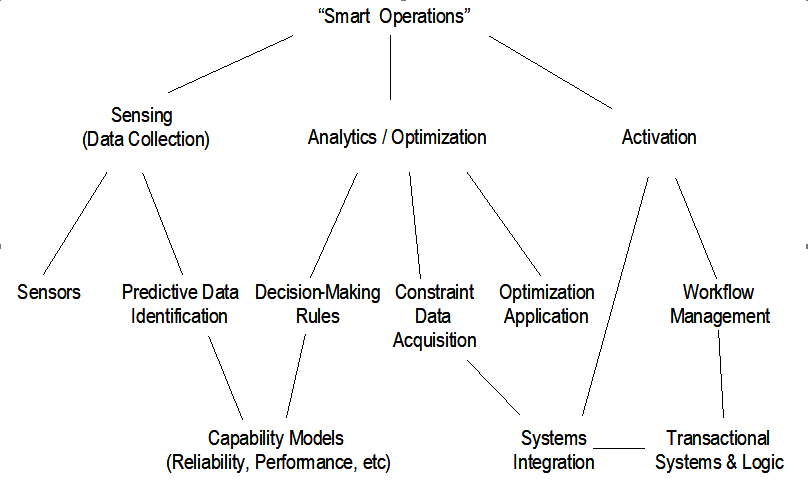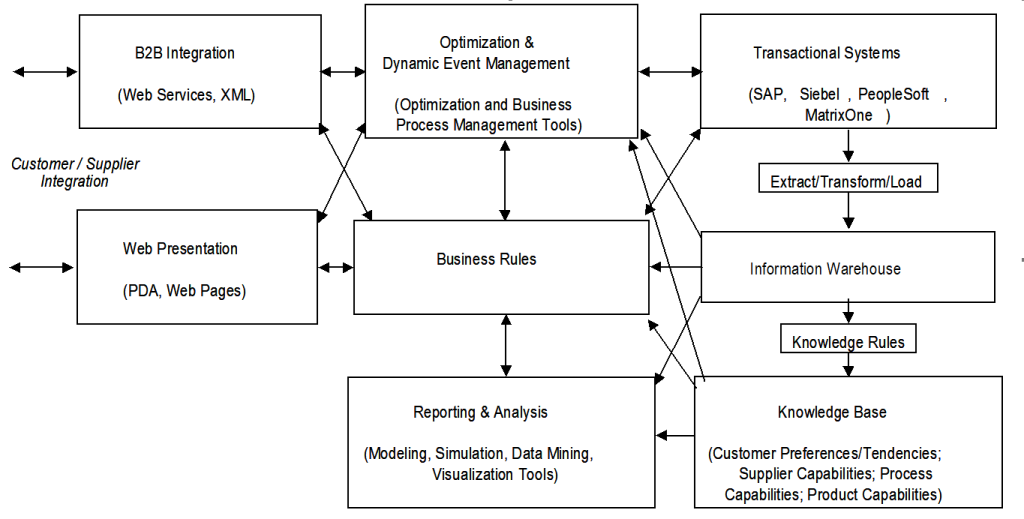Abstract—A Web Service Oriented Architecture (WSOA) has the potential to enable robust strategy design at multiple levels of the IT mission. In support of the Business, a WSOA supports fluid reconfiguration of the business model – an emerging requirement in the Aerospace industry. In the IT context, WSOA is the fundamental building block of a novel “Smart Operations” architecture. “Smart Operations” is a broad-based Sense and Respond strategy built on efficient and flexible integration of legacy, ERP, and analytical applications in a rules-based, knowledge-enabled, managed business process environment. Web Services is viewed as critical to meeting the integration challenges of a diverse systems and business environment.
Index Terms— Web Services Architecture Integration
I. INTRODUCTION
The Aerospace industry today is challenged by multiple factors – unprofitable business models, economic downturn, the war in Iraq, and threats of terrorism. While most agree on the need for change, there is little agreement on the form, timing, and magnitude of that change. Information Technology (IT) must position itself to enable an agile and flexible response to a rapidly changing business and technology environment.
Partnered with those strategic requirements is the near term need for IT to continually enable smarter and faster decision-making on the part of all business users. Of prime concern is the ability to identify, capture, manage, and use knowledge as an empowering input to the decision making process. Web Services is seen as a key enabler for the multiple types of integration required to make “Smart Operations” a reality – Application to Application; Application to Process; and Business to Business.
II. SMART OPERATIONS
A. Vision & Operating Concepts
The hypothesis of “Smart Operations” is that ever smarter, ever faster decision making by an organization contributes to sustainable competitive advantage. Business decisions are pervasive in the execution of a business’ mission: what to sell, where and with whom to transact, etc. Presenting decision-makers with the best course of action in any business scenario is a key objective and includes the use of all relevant data, information, and knowledge as well as available transactional and analytical capabilities. Complementing this rich access to information assets is a decision-making rule, optimized over hundreds or thousands of prior occurrences, that is built and executed in near real-time.
In the future, as the networked economy continues to grow and businesses continue to outsource (virtualize), an ever growing and richer set of information and knowledge becomes available. Businesses with a strategy to proactively partner on the basis of execution skills and available “Smarts” will reap higher than normal benefits as they harvest the extension of their intelligence capability.
Operationally “Smart Operations” drives radical cycle time reduction and quality improvement in the “sense – analyze & decide – act” control loop. Conventional businesses processes are typically not built with a larger strategic purpose in mind. The following are typical failure modes of today’s approach:
- We fail to collect the right data that will empower decision-making
- We fail to synthesize available information to produce smarter decisions
- Decision-making remains highly distributed and inconsistent
- We fail to integrate decisions and actions which drives long cycle times and lower quality execution
A WSOA is viewed as the primary enabler to this fully “wired” business model, driving the unprecedented flexibility for business process designers to integrate any information, logic, or transactional element (internal or external to the enterprise) with built-in dynamic optimization and process execution controls. This flexibility would be available at low cost without compromising process integrity. “Smart Operations” consists of three critical elements: Sensing; Analytics / Optimization; and Activation as shown in Figure 1.

Fig. 1. “Smart Operations” Components
B. Sensing
Sensing is the critical first step in a “Smart” operation as it serves as the eyes of the business. The collection of data or information of interest keys the organization to either opportunity or risk and initiates the Sense-Analyze-Act control loop. There are two key components to the Sensing action.
The first component is to decipher precisely what data is required to feed the “Smart” operation. This is largely an analytical exercise where statistical or other techniques are used to decompose a specific decision into its vital inputs and transformation rule. Six Sigma is a particularly well-suited methodology as it focuses on establishing precise transformation functions and discerning vital inputs. Those objects align with the “Smart Operations” principles and design.
The second important component is the ability to properly instrument an analog or digital process to collect data at the proper frequency and granularity. Web Services has a natural fit in this space as a connector between physical products or business processes and the “Smart” operation. Sensing could be operated on a client / server model where a central element of the “Smart” operation regularly “calls” the product or process Sensing “Service” to report current state. This approach has merit because the control and logic is centrally managed and through rules can be tuned to adjust the frequency / granularity of the request. Alternatively the “Service” could be operated in an autonomous style that is programmed to collect and forward data according to a pre-determined schedule or in response to a “local” event.
In the future one can envision low cost, small footprint “Sensing” services being inserted or attached to either analog or digital processes. Their operation would be optionally remotely controlled or autonomous with easy configuration. Digital sensing examples would include cash flows; orders; or web hits; while analog examples would include engine RPMs; wheel rotations; or temperature changes.
C. Analysis
The integration of data, information, and knowledge promises to significantly improve the quality of business decisions. While our Knowledge Management strategy is outside the scope of this paper, it is essential to strategically plan the lifecycle of knowledge. Examples we focus on include knowledge of Customer Preferences and Tendencies, Supplier Capabilities, Process Capabilities, and Product Capabilities. Each can provide valuable insight into business behaviors.
It is envisioned that IT will encapsulate decision-making logic into business components that can be called, re-used, or cloned with ease. Web Services greatly facilitates component construction given the standardization of interfaces between legacy, ERP, and analytical applications as well as databases and other information assets. Of note the integration of analytical components provides a natural opportunity to consider a greater breadth and depth of factors relevant to the decision. This is in sharp contrast to today’s all too common situation where gut instinct and limited actual data are used to determine a course of action.
D. Optimization
The ability to optimize presents a new and compelling capability for a business to dynamically understand its available decision space within the defined objectives and constraints of a given situation. Many of the practical aspects of optimization are contemplated with the “Smart” Operation, and the rapid, low-cost ability to gather constraint data from both inside and outside the enterprise is critical.
Internally, a WSOA-based Application-to-Application integration would be leveraged to gather critical information regarding capabilities, costs, and business objectives. Similarly, a Business-to-Business integration leveraging Web Services provides access to both Customer and Supplier systems and ensures linkage to the external information sources required to fully explore the optimization space. Tactically, the development of an optimization problem framework for each business scenario provides an excellent roadmap for Application, Data, and Business Partner integration requirements. The WSOA model simplifies the construction of the scripted workflow that leverages those integrations to accumulate required constraint data.
As Web Services become increasingly robust and secure, it is envisioned that optimization analysis itself could be externally performed as an on-demand service. This would allow an enterprise access to high performance computing infrastructure yet avoid the significant expense and expertise required to construct internally. Promising developments like Grid computing would bring large-scale computational horsepower at a fraction of the internally built and maintained expense levels. The use of such external analytical services would themselves be process rule driven to best optimize the trade-off between cost of service and speed of response.
E. Activation
The classic application of a WSOA is the “Activation” phase. Activation is our business term for the orchestration of an arbitrary number of internal and external business resources directed to deliver optimal execution against a defined business objective. The centerpiece of this “Smart” component is a robust Business Process Management (BPM) tool that supports rapid and low-cost integration of all business assets (legacy, ERP, and analytical applications) into an instrumented and managed process environment. The BPM would execute pre-defined logic to guide process execution, while simultaneously self-managing execution integrity. Even intelligence about individual step and end-to-end execution performance would be collected and re-used to control future process execution. The BPM fluidly uses loosely coupled Web Services (to allow flexibility in tasking) to invoke transactions, process information, or perform any other required task seamlessly, either inside or outside the enterprise.
As the level of sophistication increases, the executing Business Process will respond to “Sensed” events that drive an element of the current solution set outside its optimized slack boundaries. Out-of-bounds conditions would drive a Solution re-optimization and potential re-tasking of assets. To provide this level of flexibility it is imperative that Sensing, Optimization, and Orchestration become fast, low-cost, and reliable. In the future, extended processes could entail months of cycle time with dozens or hundreds of assets performing thousands of tasks.
III. IT Strategy
It is worthwhile to look at the IT Strategy for developing and building out the “Smart Operations” concept. Although this strategy is optimized for the ES&S environment there are important considerations that may have broader applicability.
A. “Cheap / Reliable Data”
Phase I of the ES&S IT Strategy is the consolidation and rationalization of numerous overlapping applications, data models, and business processes that today make “Smart Operations” a difficult proposition. Phase I has two critical objectives – consolidation of legacy systems and process rationalization.
It is anticipated that significant IT cost savings will be realized by large-scale systems consolidation. Significant reduction in IT’s cost of application support are possible and allows a much higher percentage of the total IT spend to be dedicated to new development. Systems consolidation also positions the business to productively engage in the required inter-company integrations encountered in Phase II.
Rationalization of process and data will also pay operational dividends for ES&S as a business. Particularly important is the standardization of business processes and the resulting impact on Customer satisfaction. Further, this rationalization will facilitate sharing of best practices and human resources. Importantly for “Smart Operations,” this rationalization enables increased confidence in the mining of historical data and information to create enabling knowledge. The opportunity to learn at a faster rate will be a significant factor in the overall magnitude and timing of payback for “Smart Operations.” Much of Phase I will be accomplished within the larger Honeywell Aerospace Backbone (ERP) program.
B. Customer / Supplier Integration
With the completion of Phase I, IT will be positioned to efficiently engage in a proactive strategy to integrate with key Customers and Suppliers. Fortunately the resource commitment to accomplish this phase is far less than Phase I. It is however no less important as it provides a window to the elements of the ES&S value chain that exist externally. Orchestration of those external assets within a “Smart Operations” model keenly depends on cheap and reliable integration. Additionally, Customers will continue to expect higher degrees of Supply Chain transparency coupled with robust access to their Suppliers’ data. Fortunately, existing standards continue to gain wider adoption which speeds business partnering.
C. Smart Operations
While Smart Operations is the subject of this paper it is worth noting that many other factors require attention to deliver on the opportunity. Foremost is the strong orientation to business process on the part of both IT and the business. This is largely new territory for IT and new skills – modeling, process design and management, simulation, data mining – will become critical. The business itself will necessarily become more deeply involved in using robust analytics to diagnose, reconfigure and optimize process execution. Our vision sees IT and business analysts working side-by-side to discover and implement ever smarter, faster process execution.
IV. IT Architecture
ES&S IT has created a reference architecture (Fig. 2.) that logically depicts the critical building blocks of the “Smart Operations” concept. Of note (and not explicitly shown) is the assumption of pervasive integration between each logical element. Further, please note that this logical design may differ significantly from the final physical design. It is expected that the future will bring a wider selection of integrated tools that integrate multiple elements of required functionality. Optimally, IT Architects will construct this design with a minimum of disparate solutions in order to minimize implementation time and resources.
A. B2B Integration
Classic B2B Integration is contemplated with full support for current and emerging XML and Web Services standards. Seamless B2B integration is critical to provide the window to external resources, whether those resources are transactional, informational, or analytical.

Fig. 2. “Smart Operations” Reference IT Architecture
B. Web Presentation
The Web Presentation component serves to provide integration with a full complement of human operated devices (PDA, Web Browsers, Smart Phones). This channel provides rapid access to human decision makers and field personnel. Content would be automatically re-purposed to fit the target device and process management rules would manage all human-in-the-loop considerations.
C. Optimization & Dynamic Event Management
This element is the heart of the activation capability for the architecture. Pre-established optimization models are housed and invoked in response to Business Rules or process events. Event management is the domain of the BPM tool that also uses analytic capabilities to ensure optimized, robust process execution.
D. Business Rules
The Business Rules component is the key integrator of data, information, and knowledge during the execution of a single decision rule. This is perhaps the most “logical” of elements as the Rules themselves may be managed within the BPM tool as logic components. That placement may prove most productive for Business Process Designers. The strategic intent is to depict that those Rules are to be maintained within a logical tier such that they are readily accessible to whatever application or process requires them.
V. WSOA Requirements
There are a number of critical requirements that must be met by WSOA components to truly empower the “Smart Operations” concept. The following are intended to promote discussion around the requirements and timing of standards, tools, and services that enable “Smart” as a viable strategy.
- Web Services should have a low cost, small operating footprint suitable for pervasive deployment and embedded applications.
- Web Services and the Business Process Execution Environment must be fully instrumented to enable robust performance management. Intelligence surrounding cycle time and quality of execution will itself be invaluable to the BPM mission.
- Creation of a distributed security management approach will greatly enable distributed sensing requirements and protect information about data collection and forwarding.
- Creation of standards about the (dynamic) distribution of business logic will also provide significant benefits for the process designer. In some near real-time applications the distribution of logic will be imperative to meet performance requirements.
- Configuration Management of Web Services both within and across enterprises will drive significant productivity and provide confident handling of a challenging environment.
VI. NEXT STEPS
ES&S IT sees a few critical next steps to efficiently progress toward the “Smart Operations” vision. These steps span organizational, financial, and technical boundaries but further position the organization for long term contribution.
- Proactively educate the business on the value of a process focus and promote analytical approaches to understanding key process drivers
- Engage IT associates in discussions and specific training in WSOA technologies. Create a Center of Expertise to drive rapid development and deployment of corporate standards
- Engage Customer and Supplier IT to determine the external operating environments and aid development of robust strategic integration plans
